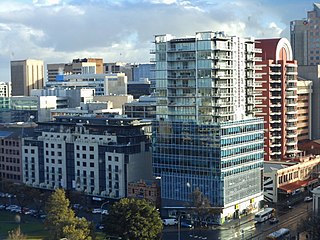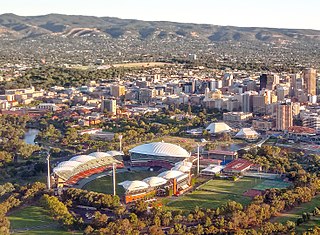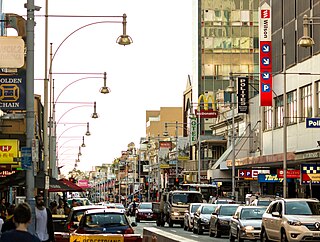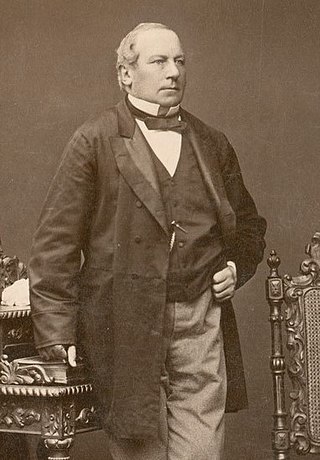
Rundle Mall is a pedestrian street mall located in Adelaide, South Australia. It was opened as a pedestrian mall in September 1976 by closing the section of Rundle Street between King William Street and Pulteney Street, to vehicular traffic. The street continues as Rundle Street to the east and Hindley Street to the west.

North Terrace is one of the four terraces that bound the central business and residential district of Adelaide, the capital city of South Australia. It runs east–west along the northern edge of "the square mile". The western end continues on to Port Road and the eastern end continues across the Adelaide Parklands as Botanic Road.

The East End is a part of the Adelaide central business district, in the north-east corner of the Adelaide city centre. This area is a popular office and retail district and has an increasing residential interest from the building of high-density luxury apartments in the area.

Hindmarsh Square/Mukata is one of five public squares in the Adelaide city centre, South Australia. It is located in the centre of the north-eastern quarter of the city, and surrounds the intersection of Grenfell and Pulteney streets, near the eastern end of the Rundle Mall. Pirie Street forms the southern boundary of the square.

Adelaide city centre is the inner city locality of Greater Adelaide, the capital city of South Australia. It is known by locals simply as "the City" or "Town" to distinguish it from Greater Adelaide and from the City of Adelaide local government area. The population was 15,115 in the 2016 census.

John Martin & Co. Ltd, colloquially known as John Martin's or simply Johnnies, was an Adelaide-based company which ran a popular chain of department stores in South Australia. It operated for more than 130 years, from 1866 until its closure in 1998. Johnnies, owned by the prominent Hayward family for the majority of its existence, became an Adelaide icon, responsible for the famous Adelaide Christmas Pageant. It was latterly owned by David Jones.

Pulteney Street is a main road which runs north-south through the middle of the eastern half of the Adelaide city centre, in Adelaide, South Australia. It runs north-south from North Terrace, through Hindmarsh and Hurtle Squares, to South Terrace, where it becomes Unley Road. It is the only one of the city centre's major north-south thoroughfares that does not continue northwards over North Terrace.

The Myer Centre is a five-level shopping centre in the heart of the Adelaide city centre, South Australia.

Hindley Street is located in the north-west quarter of the centre of Adelaide, the capital of South Australia. It runs between King William Street and West Terrace. The street was named after Charles Hindley, a British parliamentarian and social reformist.

Foy & Gibson, also known as Foy's and later Cox-Foys, was one of Australia's largest and earliest department store chains. A large range of goods were manufactured and sold by the company including clothing, manchester, leather goods, soft furnishings, furniture, hardware and food.

William McMinn was an Irish-born Australian surveyor and architect, based in Adelaide in the colony of South Australia.
East Terrace is a road that marks the eastern edge of the Adelaide city centre in Adelaide, South Australia.

William Paxton was a South Australian colonist who arrived in the Province of South Australia in 1840, became one of the investors in the Burra copper mines and returned to England in July 1855, as a wealthy man.
William Storrie, pen name Saunders McTavish, was a businessman and politician in the early days of the colony of South Australia.
Malcolm Donald Reid was a South Australian timber merchant and businessman, founder of several furniture stores that bore his name.
J. T. Fitch & Son was an Adelaide drapery store established by John Thomas Fitch, and carried on by his son John Thomas Fitch, jr.

Gawler Place is a single-lane thoroughfare in the city centre of Adelaide, the capital of South Australia. Somewhat narrower than other busy streets in the Central Business District, it runs north to south from North Terrace to Wakefield Street, parallel to and approximately midway between King William and Pulteney streets.
Emanuel Cohen was businessman in South Australia, and was responsible for the erection of several of Adelaide's premier buildings.

Charles Atkins Hornabrook was a businessman in the colony of South Australia who made a fortune from property development in the city of Adelaide and investments in Broken Hill Proprietary and other mining prospects. He is remembered as the owner and developer of the York Hotel, at the time regarded as Adelaide's finest.
James Marshall & Co. was a department store in Adelaide, South Australia, which was taken over by Myer in 1928.
























